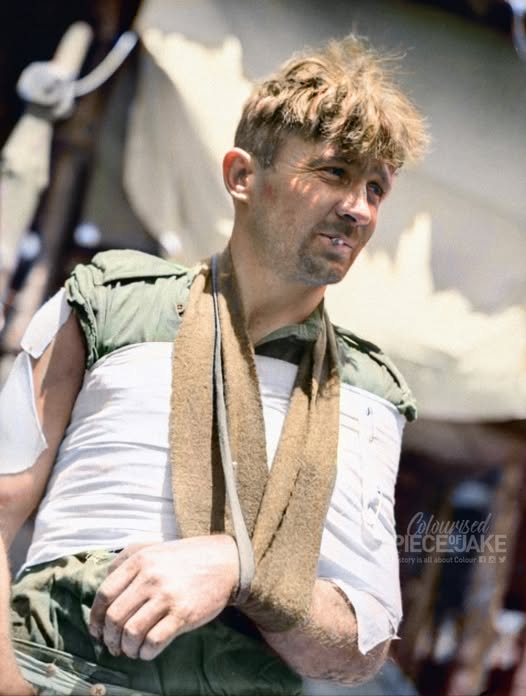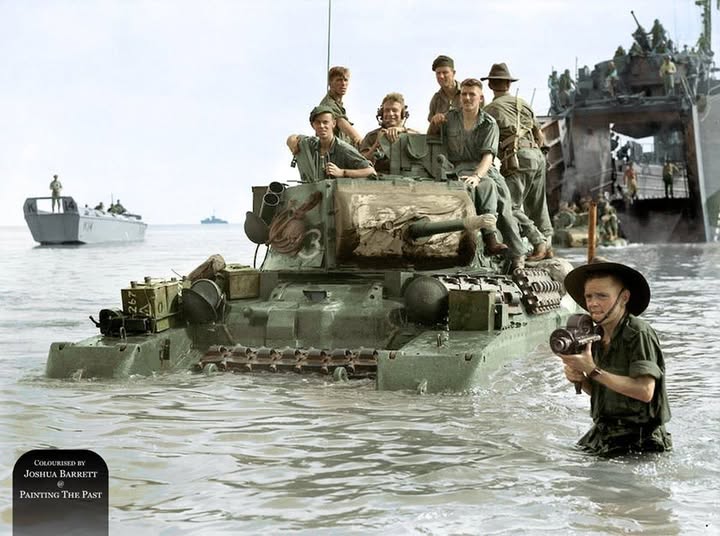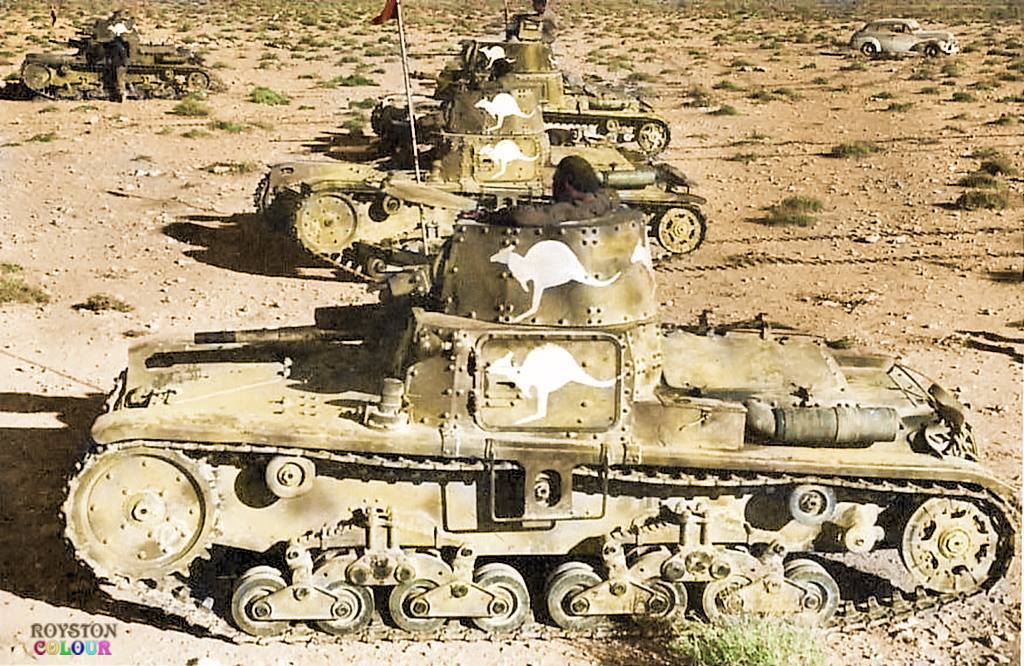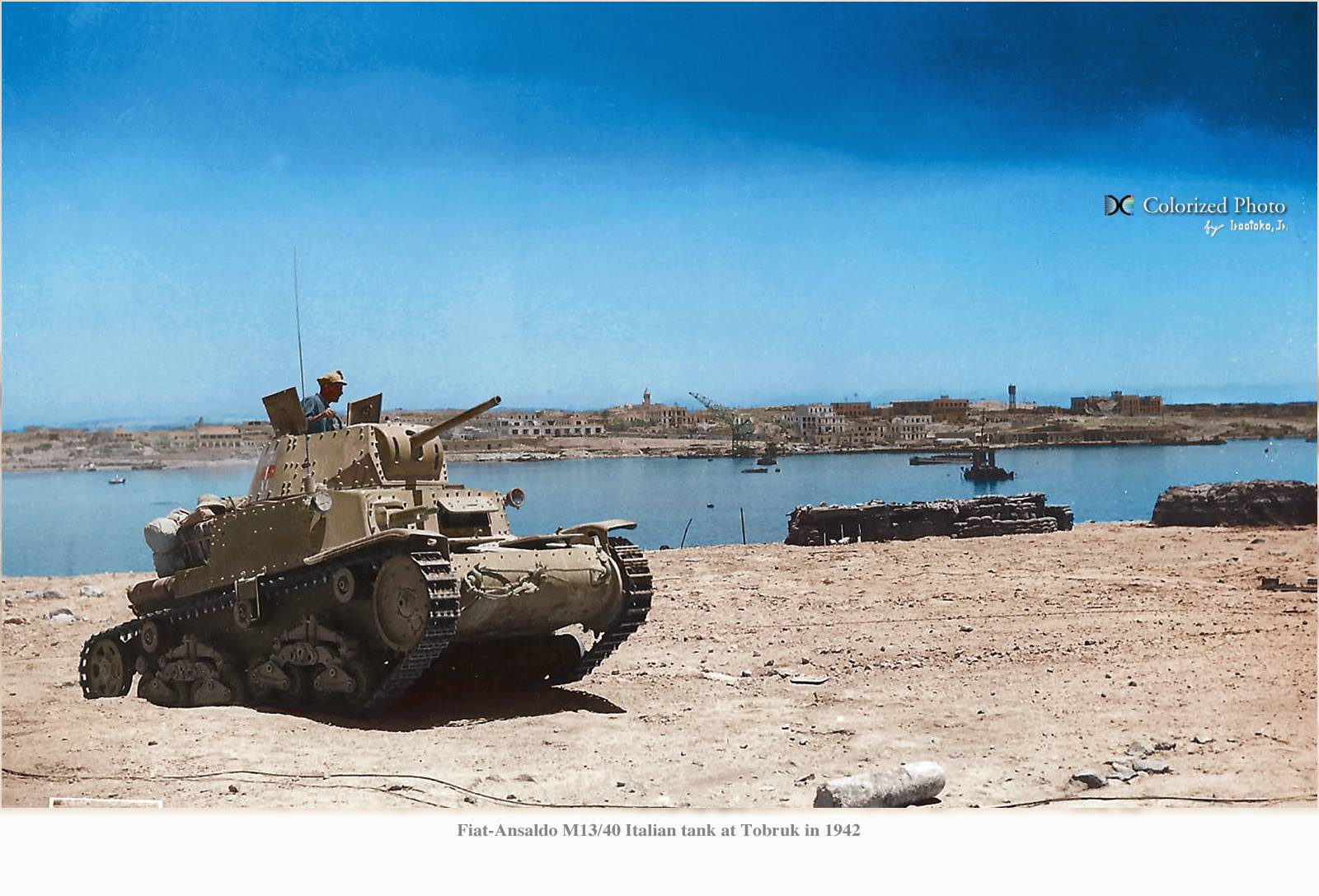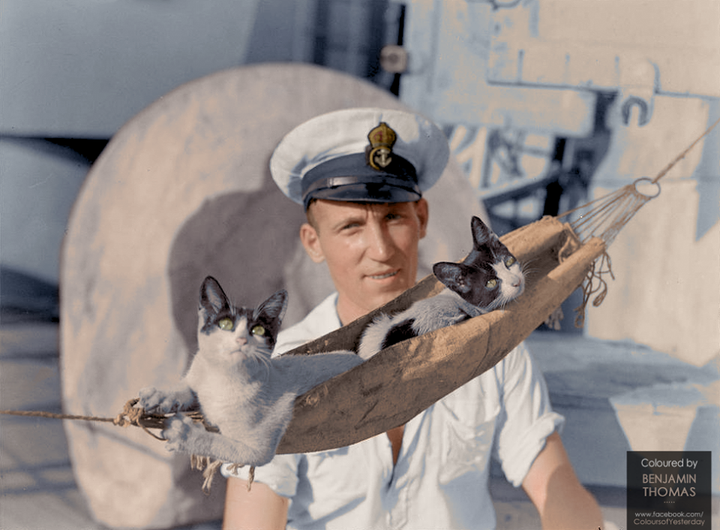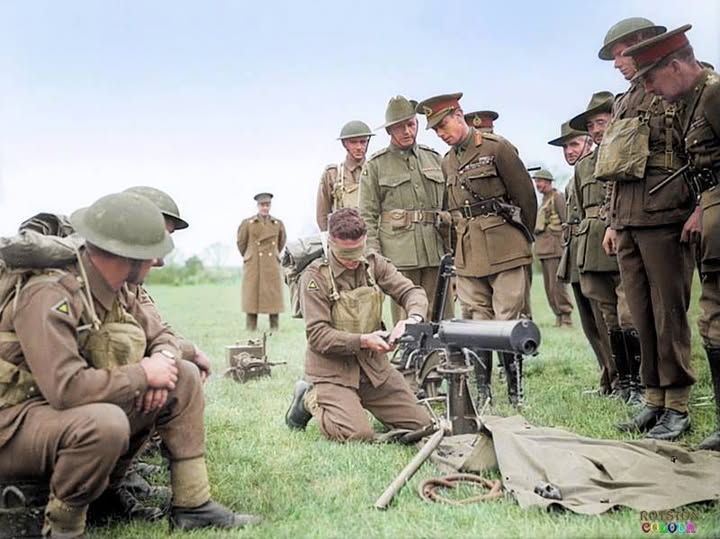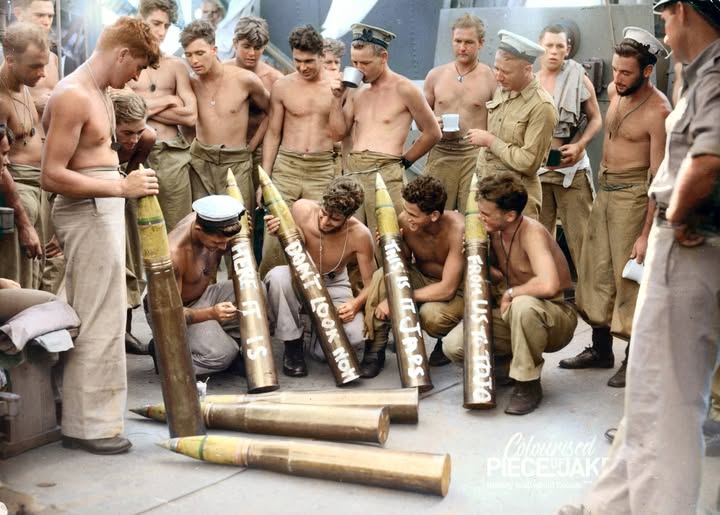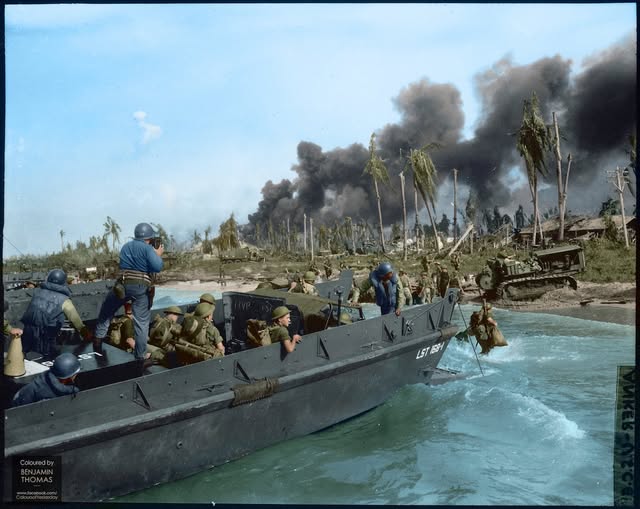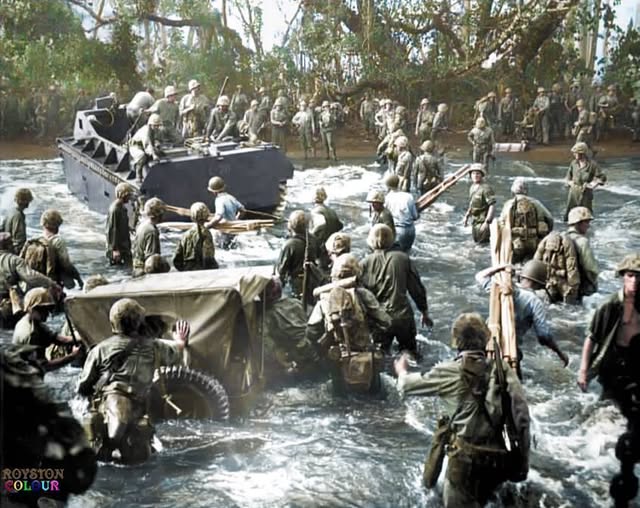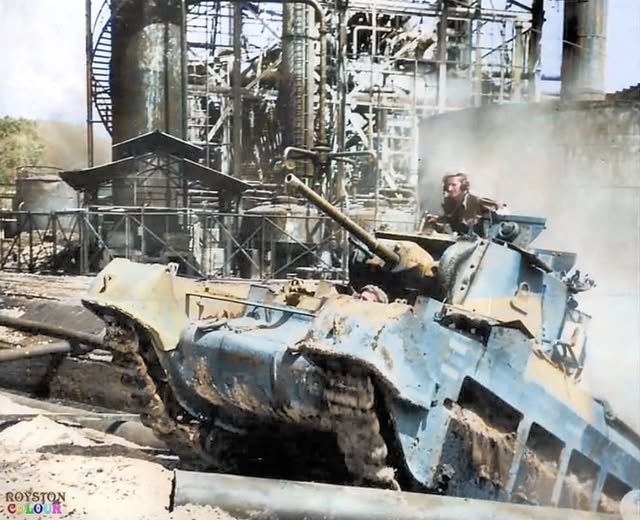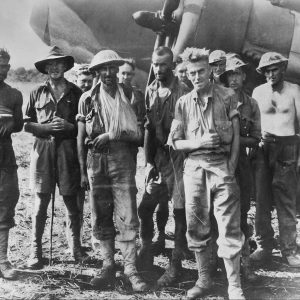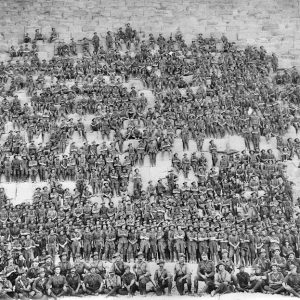30 July 1943This famous photograph by war correspondent Gordon Short captures Australian Leslie ‘Bull’ Allen rescuing a wounded American soldier on Mount Tambu, New Guinea.During an American assault against the Japanese on Mount Tambu, more than 50 US soldiers were injured. Two medics were killed trying to retrieve them.The Australians were not supposed to be involved in the fighting, but having witnessed so many casualties, Allen, a stretcher-bearer, was determined to do what he could.The Australian War Memorial record for the photograph states:“1943-07-30. Mount Tambu, New Guinea. 2/5th Battalion stretcher bearer Corporal Leslie ‘Bull’ Allen MM, age 26, of Ballarat, Victoria, carrying to safety an American soldier who had been knocked unconscious by a mortar bomb. Allen carried out twelve American casualties while under fire on Mount Tambu. For this gallantry he received the United States Silver Star. He had won his Military Medal as a Private on 7 February 1943 at Crystal Creek, Wau.”A Ballarat filmmaker who researched Allen’s story, Lucinda Horrocks, says what the soldier did next was extraordinary.”So this is the point at which Bull decides to go up and start carrying men out one at a time over his shoulder, through this terrain, facing the snipers and the machine gun fire and the mortar fire,” she said.Amateur historian David Cranage says each time he went back for another rescue attempt, soldiers would make bets on whether he would return.”Backwards and forwards, backwards and forwards. Magnificent courage, unbelievable,” he said.”I’ve never heard anything like it before in my life and I’ve spent many years studying military history.”Remember, he was carrying men from another country.”His heart was so big. He just hopped in. It wouldn’t matter where you came from. That’s the mark of the man.”It was an act of bravery worthy of place in Australian folklore.Now, 70 years after the bloody Wau-Salamaua campaign fought in Papua New Guinea, historians are calling for the military’s highest honour, the Victoria Cross, to be posthumously bestowed on Australian war hero Leslie ‘Bull’ Allen.
wounded during the Battle of Isurava on the Kokoda Track in late August 1942.
Nash made his way back to the base on foot taking 7 days to cover the distance. Nash was evacuated to Port Moresby New Guinea, then Brisbane Australia due to his injury.
In what became the first major battle of the campaign, the two sides fought a heavy engagement around Isurava in late August, as four Australian infantry battalions attempted to fend off attacks by a similarly sized Japanese force. On the other side of Eora Creek, clashes were fought around Abuari, as a Japanese battalion attempted to outflank the Australians at Isurava from the west, and cut the track around Alola, while another Japanese battalion attempted to flank Isurava to the west.
Subjected to a heavy Japanese artillery bombardment, and lacking their own with which to counter this indirect fire, the Australians defended for four days, before conducting a withdrawal in contact, falling back towards Templeton’s Crossing, which was the scene of further fighting in early September 1942.
Harold returned to Perth Australia after the war. He passed away on July 19, 1995 at the age of 84.
10th June 1945.
Matilda MK.II tank of the 2/9th Armoured Regiment with Australian soldiers in landing on Green beach (now Muara Beach) the island of Labuan, Borneo.
“….Matilda tanks of 2/9 Armoured Regiment being driven ashore through the surf from the Landing Ship Mechanised 237, at the north end of Green Beach during the ‘Oboe Six Operation’.
Identified personnel are: (left to right, on tank) Trooper (Tpr) A Kenny; unidentified; Corporal (Cpl) J A Murphy; unidentified; Tpr S L Cockram; unidentified. Cpl D C Hardy, official photographer, Military History Section Land Headquarters, is in foreground, in the water, carrying his camera…”.
Some 20,000 Australian personnel were involved in the Brunei landings.
(Source – Australian War Memorial Image Nº.108957)
An Italian Carro Armato M13/40 Medium Tank at Tobruk in 1942.
The M13/40 was based on the Fiat M11/39 series and was directly influenced by the British Vickers 6-ton tank.
Enough M13/40 tanks were abandoned by the Italians and subsequently captured by British and Commonwealth forces that they stocked the ranks of the British 6th Royal Tank Regiment and the Australian 6th Cavalry Regiment only to be used against their former masters.
These tanks were accordingly marked to avoid incidences of ‘friendly fire’ in the vast desert campaign.
The M13/40s participated in the famed Second Battle of Alamein which went down in history as a major Allied victory.
(Colors by Irootoko jr. and Royston Leonard)
Aboard the HMAS Nizam, the ship’s cats have a custom made cat hammock to themselves, June 1941.
Australian N class destroyer Nizam was one of the “Tobruk ferries” – assisting supply to the Australian garrison, besieged at the Lybian town of Tobruk.
She made fourteen runs before receiving damage on 14 September; a near-miss from a bomb cracked two oil pumps, and the destroyer was towed away from the area by the destroyer HMS Kingston, then was able to make temporary repairs and reach Alexandria.
AWM/Wiki
Photographer: George Silk
Image courtesy of the Australian War Memorial
(Colourised by Benjamin Thomas from Australia)
King George VI inspects the skills of a blindfolded Australian Vickers machine gunner from the 2/1st Machine Gun Battalion, 18th Brigade, 6th AIF Division which was based in the United Kingdom in 1940.
(Possible taken at Colchester during October 1940)
In May 1940, the brigade embarked on HMT Queen Mary for the United Kingdom, arriving there in June. Established at Tidworth Camp in Wiltshire, and then later at Colchester, the regiment was employed on garrison duties to defend against a potential German invasion following the Fall of France.
In November, as the threat of invasion seemingly passed, they received orders to move to Glasgow to embark on the transport ‘Otrango’, bound for the Middle East where they were to rejoin the rest of the 6th Division.
(Photo source – Australian War Memorial collection 004573)
• Anzac Day •
Gunners of HMAS Shropshire prepare some shells for her secondary armament with a with a ‘personal message’ for the Imperial Japanese Army.
HMS Shropshire was a Royal Navy (RN) heavy cruiser of the London sub-class of County-class cruisers. She is the only warship to have been named after Shropshire, England. Completed in 1929, Shropshire served with the RN until 1942, when she was transferred to the Royal Australian Navy (RAN) following the loss of sister ship HMAS Canberra.
The cruiser was involved in the Battle of Luzon during January 1945, during which she was attacked by two kamikaze aircraft: one narrowly missed, while the second was shot down by HMAS Gascoyne close enough for debris to hit Shropshire. Shropshire fired in anger for the last time during the Corregidor landings, then briefly returned to Australia.
Shropshire returned to the Philippines in time for the Japanese surrender of the islands, then proceeded to Japan, and was present at Tokyo Bay on 2 September 1945 for the signing of the Japanese Instrument of Surrender.
The cruiser’s wartime service with the RAN was recognised with five battle honours: “New Guinea 1943–44”, “Leyte Gulf 1944″, Lingayen Gulf 1945”, “Borneo 1945”, and “Pacific 1945”.
Only five personnel died during the ship’s RAN service, but although all five occurred during World War II, none were the result of enemy action; one drowned, and the other four were the result of accidents.
Commissioned as HMAS Shropshire, the ship remained in RAN service until 1949, and was sold for scrap in 1954.
Colour: ColourisedPieceofJake
ANZAC Day 2022
An LCVP (Landing Craft Vehicle Personnel) from the US Coast Guard’s USS LST-168 taking Australian troops of the 7th Division ashore during the landings at Balikpapan, southeast coat of Borneo, on 1 July 1945.
The landings, slightly north of Balikpapan itself, formed the final stage of Operation OBOE-2 and had been preceded by heavy shelling and aerial bombing by both the Australian and US Air Forces, and Navies. Like many similar Pacific battles at this late stage of the war, the Japanese forces were outnumbered and outgunned, but many adopted to fight to the death.
It was a sizeable operation with more 33,000 army, air force and navy personnel landed from 1 July 1945, in what would be the largest ever amphibious assault by Australian forces.
An oil-port, Balikpapan had seven piers, a refinery and a large number of warehouses around the docks which were quickly set alight during the initial bombardment. The smoke in the background is the result of the burning oil refinery.
Standing on the LCVP is US Coast Guard Combat Photographer James L. Lonergan, filming the action. The image itself was taken by another Coast Guard photographer, Gerald C. Anker.
Image courtesy of the US National Archives
‘Operation Dexterity’
December 26, 1943
After the terrific bombardment which pulverized Japanese defences on the beaches of New Britain, American troops swarmed ashore at Cape Gloucester in the northwest of New Britain, on December 26 1943 and firmly established a beachhead.
In this photo, US 1st Marines arriving at ‘Yellow Beach 1’, manhandle a jeep through shallow water after unloading it from a landing craft; in the background is an “alligator”, a general utility land-and-water transport vehicle.
(The second phase consisted of a drive on the airdrome by the 1st Marines (less 2d Battalion). Forward elements of the 3d Battalion of that regiment came in on LCI’s behind 3/7 on YELLOW 1 at 0815, passed through that unit, and not long thereafter ran up against one of Colonel Sumiya’s road blocks: four strong bunkers armed with as many machine guns, together with a system of rifle trenches.) (ibiblio.org)
On December 26, 1943, the First Marine Division commanded by Major General William H. Rupertus (veteran of Haiti, China and Guadalcanal) landed at Cape Gloucester after a brief naval bombardment and aerial smoke screen, landing at Yellow Beach 1 & 2 and Green Beach. The Marines faced swampy terrain and thick jungle, but met only rear-echelon Japanese troops. Some criticized the landing unnecessary, as the Allies already had total control of the Huon Peninsula of New Guinea.
Two new weapons were introduced during the battle: the M1 Garand rifle and M4A1 Sherman tank. Also, L-4 and L-5 Liaison planes were used for spotting, supply drops and message relay. Once secured, the Marines advanced eastward along the north coast capturing the Willaumez Peninsula. Once the area was secured, the Marines were relived by the U. S. Army 40th Division, commanded by Major General Rapp Brush who were later relieved by the Australian 5th Division.
(Photo source – USMC)
(Colourised by Royston Leonard)
7th Australian Division Matilda Tank in Action at Balikpapan 1945.

Australians driving Bren Carriers towards Bardia, Libya, January 1941

We talked about the United States naming warships to honor Australia over the past few articles. I thought I would bring the series to a close and flip the script a bit by looking at an Australian warship named to honor the United States.
Following the last stand by forces of the United States and the Philippines at the Battle of Bataan, Australia chose to rename one of its three tribal class destroyers HMAS Bataan to honor the battle.
Laid down in April of 1942, the destroyer was originally to be named Chingilli and then later Kurnai. However, prior to the destroyer’s launching ceremony, the decision was made to rename the ship HMAS Bataan. This was also decided upon after learning that the US was planning to name a cruiser after HMAS Canberra, reciprocating the gesture.
The newly named HMAS Bataan was launched on January 15, 1944 by Jean MacArthur, wife of Douglas MacArthur. Fitting out took another year and HMAS Bataan was not ready for combat until May of 1945.
By the time she reached Japan, hostilities were all but over, preventing her from seeing combat during WW2. However, she was present in Tokyo Bay for the surrender ceremony. Afterwards, she remained in Japanese waters as a show of Australian force, helping bring Australian prisoners of war back home.
HMAS Bataan would later see service during the Korean War, serving two tours during that conflict. She would ultimately be paid off in 1954 and placed in reserve. Plans to modernize the ship were never carried out and she was scrapped in 1958.

